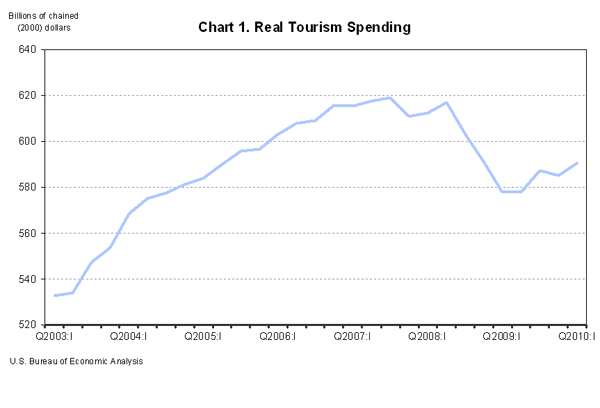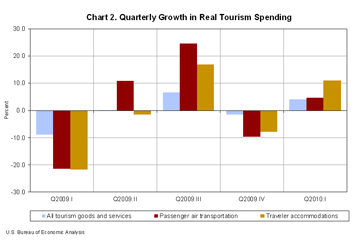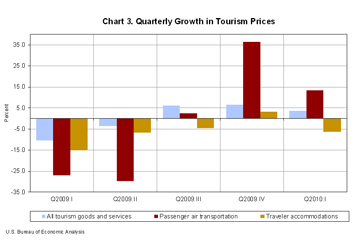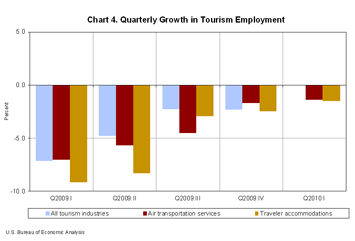Real spending on travel and tourism increased at an annual rate of 3.9 percent in 2010:1, following a decrease of 1.5 percent (revised) in 2009:4. By comparison, real gross domestic product (GDP) increased 3.0 percent (second estimate) in 2010:1 after increasing 5.6 percent in 2009:4. Travel and tourism prices increased 3.5 percent in 2010:1 after increasing 6.5 percent (revised) in 2009:4.
- Passenger air transportation spending increased 4.5 percent in 2010:1 after decreasing 9.8 percent (revised) in 2009:4.
- Accommodations spending turned up, increasing 11.0 percent in 2010:1 after decreasing 7.9 percent (revised) in 2009:4. Accommodations provided the largest contribution to growth in the quarter.
- Prices for passenger air transportation increased 13.3 percent in 2010:1.
 Direct tourism-related employment was unchanged in 2010:1, following a 2.3 percent (revised) decline in 2009:4. By comparison, overall U.S. employment increased 0.2 percent in 2010:1 and decreased 1.3 percent (revised) in 2009:4.
Direct tourism-related employment was unchanged in 2010:1, following a 2.3 percent (revised) decline in 2009:4. By comparison, overall U.S. employment increased 0.2 percent in 2010:1 and decreased 1.3 percent (revised) in 2009:4. Real Tourism Spending. Real spending on passenger air transportation increased 4.5 percent in 2010:1, despite a 13.3 percent increase in prices. Traveler accommodations turned up, rising 11.0 percent, as prices decreased 6.4 percent.
Real Tourism Spending. Real spending on passenger air transportation increased 4.5 percent in 2010:1, despite a 13.3 percent increase in prices. Traveler accommodations turned up, rising 11.0 percent, as prices decreased 6.4 percent.
 Tourism Prices. Prices for passenger air transportation grew for the third straight quarter, rising 13.3 percent in 2010:1. Prices for traveler accommodations turned down, declining 6.4 percent after increasing 3.1 percent in 2009:4.
Tourism Prices. Prices for passenger air transportation grew for the third straight quarter, rising 13.3 percent in 2010:1. Prices for traveler accommodations turned down, declining 6.4 percent after increasing 3.1 percent in 2009:4.
Tourism Employment. In 2010:1, employment decreased 1.4 percent in air transportation services and 1.5 percent in traveler accommodations. There was no growth in overall travel and tourism employment. Growth in food services and shopping offset declines in air transportation and accommodations.
Total Tourism-Related Spending. The U.S. production generated by tourism spending not only includes the goods and services that are purchased directly, but also the inputs used to produce these goods and services — indirect tourism-related spending. In 2010:1, total current-dollar tourism-related spending was $1.3 trillion and consisted of $737 billion (57 percent) of direct tourism spending — goods and services sold directly to visitors — and $567 billion (43 percent) of indirect tourism-related spending — goods and services used to produce what visitors buy.
 Total Tourism-Related Employment. In 2010:1, total tourism-related employment was 8.1 million and consisted of 5.6 million (69 percent) direct tourism jobs — jobs where workers produce goods and services sold directly to visitors — and 2.5 million (31 percent) indirect tourism-related jobs — jobs where workers produce goods and services used to produce what visitors buy.
Total Tourism-Related Employment. In 2010:1, total tourism-related employment was 8.1 million and consisted of 5.6 million (69 percent) direct tourism jobs — jobs where workers produce goods and services sold directly to visitors — and 2.5 million (31 percent) indirect tourism-related jobs — jobs where workers produce goods and services used to produce what visitors buy.
Definitions
Tourism spending. Tourism spending comprises all goods and services purchased by tourists (defined as people who travel for any reason). In the following tables, tourism spending is referred to as direct tourism output.
Indirect tourism-related spending. Indirect tourism-related spending comprises all output used as inputs in the process of producing direct tourism output (e.g., toiletries for hotel guests and the plastic used to produce souvenir key chains).
Total tourism-related spending. Total tourism-related spending is the sum of direct tourism spending and indirect tourism-related spending.
Direct tourism employment. Direct tourism employment comprises all jobs where the workers are engaged in the production of direct tourism output (such as hotel staff, airline pilots, and souvenir sellers).
Indirect tourism-related employment. Indirect tourism-related employment comprises all jobs where the workers are engaged in the production of indirect tourism-related output (e.g., employees of companies that produce toiletries for hotel guests and the plastic used to produce souvenir key chains).
Total tourism-related employment. Total tourism-related employment is the sum of direct tourism employment and indirect tourism-related employment.
These statistics are from BEA’s Travel and Tourism Satellite Accounts (TTSAs), which are supported by funding from the Office of Travel and Tourism Industries, International Trade Administration, U.S. Department of Commerce. The current-price statistics of direct tourism output were derived from BEA’s annual TTSAs (revised in June 2009) and from current-price quarterly statistics of personal consumption expenditures from the National Income and Product Accounts (NIPAs). The real statistics of direct tourism output were developed using price indexes from the Bureau of Labor Statistics (BLS) and real quarterly statistics of personal consumption expenditures from the NIPAs. The statistics of direct tourism employment were derived from the annual TTSAs (revised in June 2009) from BEA, the Quarterly Census of Employment and Wages (QCEW), and Current Employment Statistics (CES) from BLS.
Quarterly statistics are seasonally adjusted and expressed at annual rates, unless otherwise specified. Percent changes are calculated from unrounded data and annualized. Real values are in chained (2000) dollars. Price indexes are chain-type measures. Growth in overall U.S. employment is calculated using BLS total nonfarm employment from Current Employment Statistics.
These Travel and Tourism statistics do not reflect the results of the comprehensive revision of the annual industry accounts, released on May 25, 2010. They will be updated to incorporate this revision in fall 2010.
